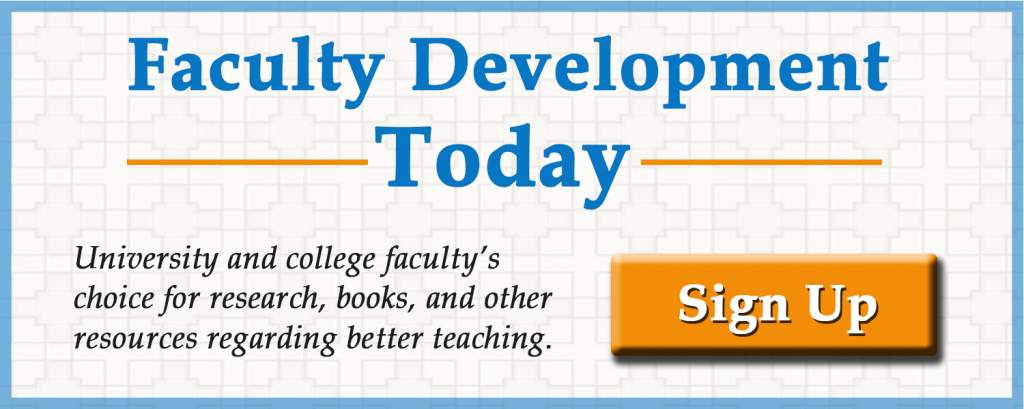Anyone who has been in faculty development for a while knows its main problem: the very clientele Centers for Teaching & Learning (CTLs) are charged with developing do not attend the events put on for them. Here, we have tried different times of the day for presentations and workshops, different locations, bribes (food usually; books sometimes), various formats, assorted presenters, and even asking the Provost to make some Professional Development (PD) mandatory, but nothing seems to gain traction for long.
Unfortunately, our CTL’s experience is not isolated. Nationally, CTL programs seem stuck with about a 10% saturation rate—i.e., 90% of the faculty remain untouched by efforts to develop them professionally. The reasons given often revolve around increased faculty responsibilities and concomitant loss of time. The rise of technology has, among other things, created a cohort of online teachers who may never set foot on campus. Whatever the suggestions, the “if you build it, they will come” mentality has proven to be ineffective in dealing with the new realities of PD.
We have developed a couple of solutions to deal with the attendance problem that we’ll be covering in the next few weeks. Simply put, we decided that if they won’t come to us, we’ll go to them, and the lynchpin of our grand idea is the Faculty Innovator (FI).
What Are Faculty Innovators?
The Faculty Innovator Program went from an idea to an implemented experiment in less than six months. We started putting the idea into practice long before the entire initiative was fleshed out and thus is an example of the applied creative thinking strategy we refer to as nascent programming. Nascent programming represents extreme risk-taking, of going with a beta program or prototype before all the kinks are worked out. Nascent programming assumes that the risk of failure is outweighed by the possibility of success, that the potential for doing something looms larger than not doing it, and that even in failing we gain valuable insights.
Our Faculty Innovators Program consists of a cadre of selected faculty members with expertise in teaching, learning strategies, classroom techniques, up-to-date technologies, and a strong desire to share that expertise with other faculty. In the spring of this year, a full six months before the start of the fall semester, we chose seven faculty members with at least one from each of the five colleges at our institution. Since then the Dean of Libraries has supported an eighth innovator, the online administration is considering supporting another, and we have asked the Deans’ Council for three more.
Our intent in choosing them so far in advance of the fall semester was that we would be able to train them in preparation of fall duties. We set up an organizational scheme whereby an Executive Committee consisting of the directors of the Noel Studio (Rusty) and the co-directors of the Teaching and Learning Center (Hal and Charlie) served as facilitators of a professional learning community (see our previous posts). The Committee created all the original documents that explained the Faculty Innovators to our overseers, the Deans’ Council—the overview of the Faculty Innovators Program, the job description of a Faculty Innovator, an even the Faculty Innovator Coordinator (one FI is chosen each year to serve as a liaison between the Executive Committee and the Innovators, and to be in charge of such things as setting up meetings). During the summer and at the beginning of the fall semester, the Executive Committee facilitated bi-weekly meetings of the PLC, a job we then turned over to the FI Coordinator.
What Do the Faculty Innovators Do?
In our job description of Faculty Innovators, we suggested some minimal requirements and tasks that all should be able to perform:
- Attend regular meetings and professional development sessions.
- Provide one presentation/year as part of our Teaching & Learning Initiative.
- Facilitate one PLC (i.e., PLC, Breakfast & a Book, Creative Community/year, including keeping records of such things as attendance, who presents what.
- Work at our August orientations (i.e., full-time faculty, part-time faculty, first-year course instructors, and teaching assistants), including introducing oneself and the FI program at the initial College meeting of the year.
- Provide individual class observations.
- Offer specialized workshops for colleges, departments, and programs.
- Maintain a record of all activities.
- Help with each end-of-the-semester assessment.
- Help train the incoming class of FIs.
- Work in the new Faculty Innovator Training Studio.
Sound interesting? Next time we’ll continue with the Faculty Innovator Program, detailing the specifics of budget, how FIs are selected, maneuvering in the political climate, and some tips on success.
Author
 Charlie Sweet is currently Co-Director of the Teaching & Learning Center (2007+) at Eastern Kentucky University. Before going over to the dark side of administration, for 37 years he taught American Lit and Creative Writing in EKU’s Department of English & Theatre, where he also served as chair (2003-2006). Collabo-writing with Hal Blythe, he has published well over 1000 items, including 15 books; of his 11 books with New Forums. Meet Charlie.
Charlie Sweet is currently Co-Director of the Teaching & Learning Center (2007+) at Eastern Kentucky University. Before going over to the dark side of administration, for 37 years he taught American Lit and Creative Writing in EKU’s Department of English & Theatre, where he also served as chair (2003-2006). Collabo-writing with Hal Blythe, he has published well over 1000 items, including 15 books; of his 11 books with New Forums. Meet Charlie.



